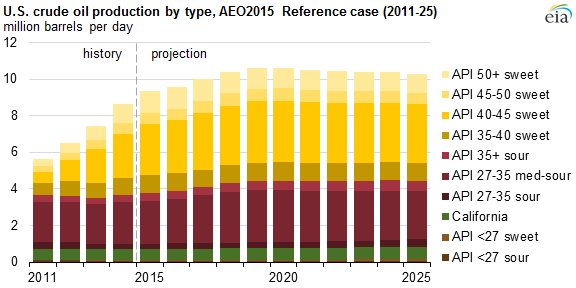July 2015, Vol. 242, No. 7
Web Exclusive
Increases in U.S. Oil Production Predominantly Light, Sweet Crude

U.S. crude oil production has grown rapidly in recent years, primarily from light, sweet crude from tight resource formations. About 90% of the nearly 3MMbpd growth in production from 2011 to 2014 consisted of light, sweet grades, meaning they have an API gravity of 40 or above and a sulphur content of 0.3% or less.
EIA’s Annual Energy Outlook 2015 projects the U.S. supply of lighter API gravity crude oil from formations in regions such as the Bakken, Permian Basin, and Eagle Ford continues to outpace that of medium and heavier crudes.
Although the rate of growth in light sweet crude slows after 2015 in the reference case, 56% of EIA’s projected production growth between 2014 and 2020 consists of sweet grades with an API gravity of 40 or above. About 33% of the growth is attributable to an increase in Lower 48 states offshore production, which is categorized as medium sour with an API gravity between 27 and 35.
The pace and duration of projected crude oil production increases are uncertain, and these factors are dependent on crude oil prices and the quality and amount of technically recoverable resources. In the outlook’s “high oil and gas resource” and “high oil price” cases, the rate of growth in tight oil production is higher than in the reference case, as light, sweet crudes make up an even greater portion of domestic crude oil resources.
EIA’s latest Short-Term Energy Outlook, issued in May, reflected continued production growth in 2015 and 2016 — although at a slower pace than in 2013 and 2014 — with U.S. crude oil production in 2016 forecast to reach 9.2 MMbpd.
Principal contributor: Dana Van Wagener





Comments